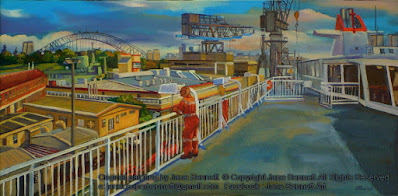 |
| DH143 Preparing for a boat lift 2007 oil on canvas 92 x 122cm Available for sale |
Today's painting on my easel on the deck gallery was a large canvas painted during my stint as "Artist in Residence" at the East Darling Harbour Wharves. Very few container ships were docked at the East Darling Harbour Wharves - in its last
5 years of operations most went to Botany, which handled container or "boxes" only.
The East Darling Harbour Wharves specialized in break bulk cargo - items that can’t be transported by container, sometimes resulting in a diverse & rather incongruous payload. Sand,
salt, gypsum was bagged or piled in gleaming unstable mounds on the wharf.
Rolls of steel, pipes & timber lengths for construction were stacked
in piles inside the sheds. Cars, vans, trucks, forklifts, excavators & agricultural machinery were driven down
the ramps of the Ro-ros at breakneck speed as though the wharfies were auditioning
for yet another remake of ‘the Italian Job’ or the ‘Fast & the Furious”,
& then parked in neat rows until they were lifted or driven onto B-doubles.
A
selection of excavators, mining or agricultural machinery and the ubiquitous
rolls of steel coils would lie for weeks inside the sheds. Luxurious 'hot-water' boats, most of which were larger than my
house and definitely cost more, were nonchalantly lifted off the ships & dangled from the cranes like giant earrings. Some of these boats were so enormous that they looked almost capable of carrying the
ship that brought them. There were even more oddball items such as helicopters, train
carriages, yachts & caravans. And one unforgettable afternoon a couple of horses broke free while being
unloaded from their box and had to be caught and restabled, turning the wharf
into a wild west show.
 |
| DH143 Preparing for a boat lift 2007 oil on canvas 92 x 122cm Available for sale |
This canvas was painted from the centre of the area between the Patrick
offices in Shed 5, looking north towards Shed 4, with the western end of
Balmain in the background. The huge white shed of White Bay can be seen in the
background in the gap between the crane & the boat that has just been unloaded.
The giant vermilion crane, “L3” is bathed in clear morning light, poised
with its pink spreader aloft in mid air. It had just placed the boats on wooden
structures known as “Nafis” so they could be hooked up to one of the 2 rather
elderly forklifts to be positioned on the wharf until they were transferred onto a B-double
truck & delivered to a marina. I asked whether the term ‘Nafi’ was an
abbreviation or a brand name, or anything to do with the naval term 'Naafi" but nobody on the wharf seemed to know the origin
of the word. Like many other items on the wharf, the Nafis were brightly
painted, mostly in primary colours, but here there is an orange one on the left
hand side & a green one on the left.
There were random clusters of them stacked neatly one on top of the
other all over the wharf.
The unnaturalistic colours of the machinery added to the pervasive feeling of living
inside a Jeffrey Smart painting. The maintenance workers, who serviced the
cranes & forklifts, always wore bright orange overalls, of exactly the same
hue as the witches hats. I know that none of it was arranged deliberately to
help me compose my painting, but there was a pleasing compositional triangle of
the orange –clothed workman striding purposefully away from the orange sled,
with the orange witches hat in the foreground. The spreader directly above his
head also has a matching orange “A” shaped crane attachment, although to strike
a discordant note, its framework is a teeth-jarring shade of pink. The reds,
pinks & oranges of the machinery stand out strongly against the large
expanse of clear pale blue sky & matching strip of sea are interrupted by
the sap green of the trees of Balmain in the background. Oddly, the
completed painting has the poise and compositional balance of Jeffrey Smart and
Edward Hopper, although painted under infinitely more trying circumstances than
a neat white studio. Although large & complex, this was a pure plein air painting- totally painted outdoors,
no photography, no tricks. Just the culmination of a lifetime of observation.
It was an eye-opening experience to be able to see first-hand, how much
work & how many people have to be involved in providing goods that we take
for granted.
This was painted in September 2007, in the last few weeks of East
Darling Harbour Wharves activity as an operational wharf. The following week,
all three shore cranes were repainted in the yellow & white colours of AT
& T livery, prior to being moved onto a barge & towed to their new
homes in Webb Dock, Melbourne & Port Kembla.
Related Posts












